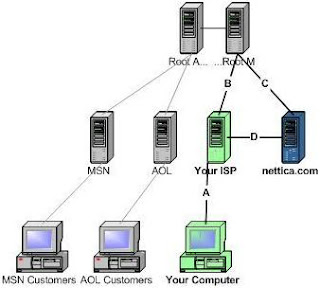DNS
Domain Name System (DNS) is an Internet Engineering Task Force (IETF) standard name service which enables applications and users to connect to hosts in TCP/IP based networks by specifying a name. DNS makes it possible to assign domain names to organizations independent of the routing of the numerical IP address. DNS is a hierarchically distributed database that creates hierarchical names that can be resolved to IP addresses. The IP addresses are then resolved to MAC addresses. DNS therefore provides the means for naming IP hosts, and for locating IP hosts when they are queried for by name.
The protocols and standards of DNS provide the following key components:
- The method for updating address information in a DNS database.
- The method for querying address information in a DNS database.
- The schema of the DNS database.
- The ability of replicating address information between DNS servers in the DNS topology.
The HOSTS files were used to resolve host names to IP addresses before DNS was in existence. The HOSTS files were manually maintained by administrators. The HOSTS file was located on a centrally administered server on the Internet. Each site or location that needed to resolve host names to IP addresses had to at regular intervals download a new copy of the HOSTS file. The size of the HOSTS file grew as the Internet grew. The traffic that was generated from downloading a new copy of the HOSTS file also grew. This led to the design and implementation of Domain Name Service (DNS) in 1984, the hierarchically distributed database that can resolve host names to IP addresses.
The main design requirement of DNS provides the following key features over the HOST file.
- A hierarchical name space
- Hostnames in the DNS database can be distributed between multiple servers
- The database has an unlimited size.
- Extensible data types
- Together with supporting host name to IP address mappings, different data types are supported as well.
- No degrade in performance as more servers are added . the database is scalable.
- Distribution of administration . naming can be managed individually for each partition.

No comments:
Post a Comment